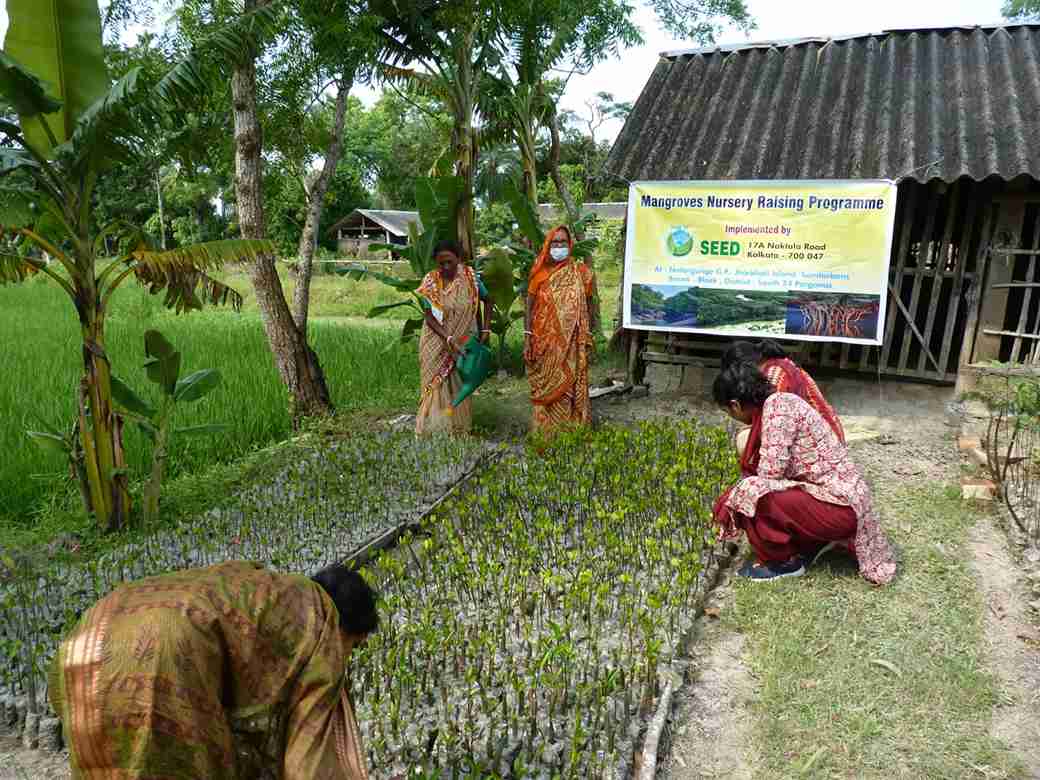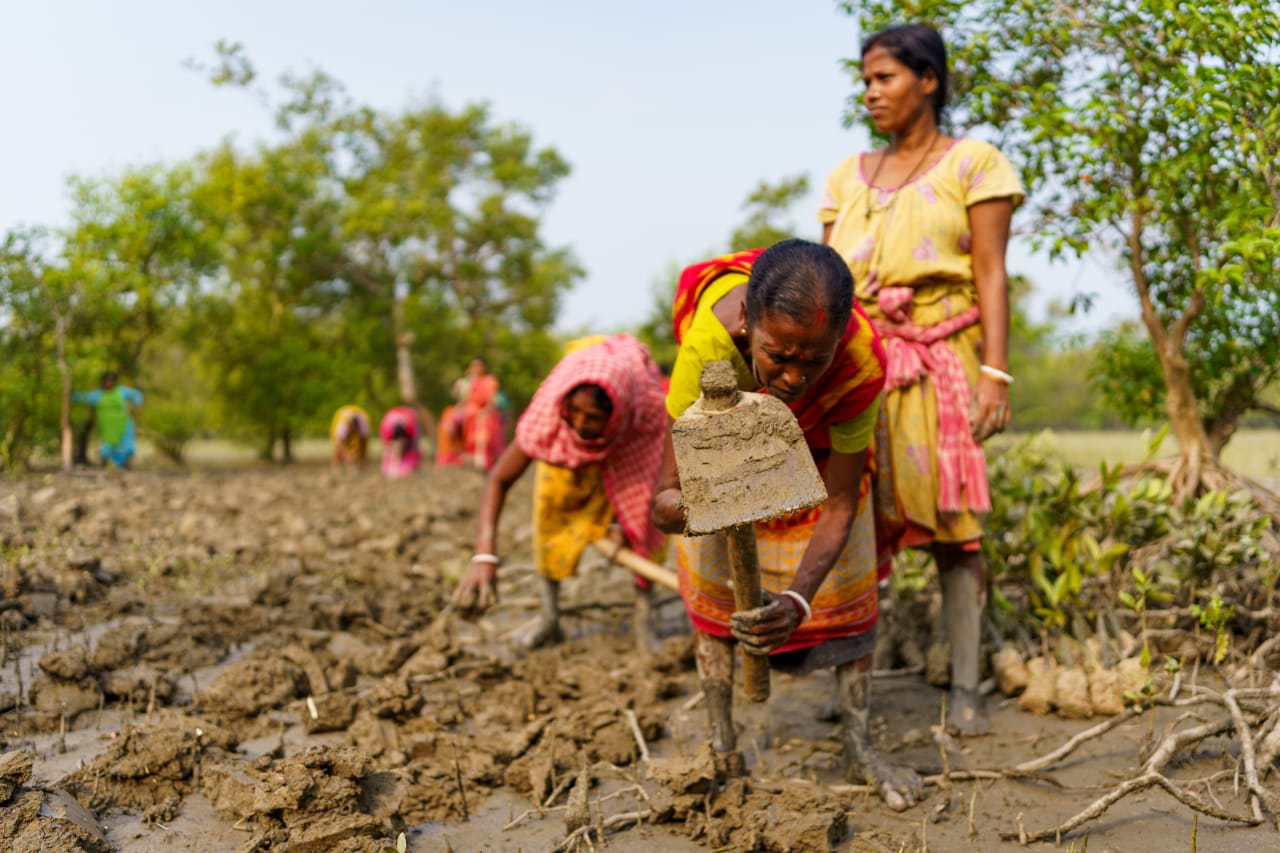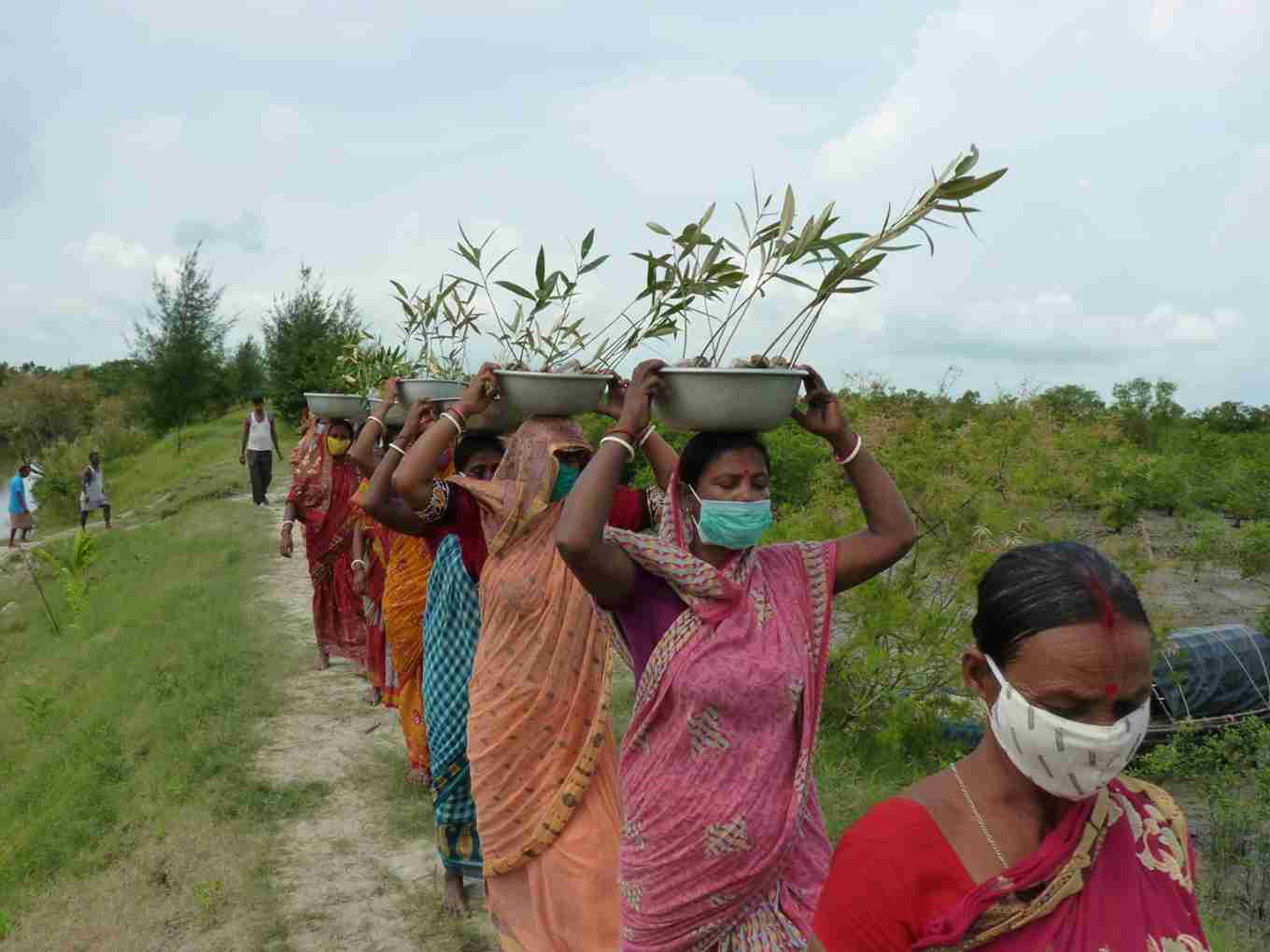Akul Biswas (extreme left) with volunteers of the Jharkhali Sabuj Bahini and a member of the Tiger Widows Organisation (in blue).
Come June, the women of Jharkhali, South 24 Parganas district in West Bengal, begin their day collecting mangrove seeds and depositing them in nursery bags.
Three months later, when the saplings are knee-high, the volunteers of Jharkhali Sabuj Bahini (JSB) will plant them to protect their homes and hearths from the
And their timely action has aided in taming nature’s fury.

Women preparing the nursery bags.
“The plantation is done between October and January. Each volunteer devotes around two hours a day to plant almost 200-250 saplings,” says Kalpana Sardar (45), an eco-warrior who has planted thousands of mangrove saplings ever since she joined JSB in 2021.
Along with more than 200 JSB members spread across 23 villages, Sardar has planted lakhs of mangrove saplings so far under the guidance of Akul Biswas, a visually-challenged person.
“We have been able to tame the bonna (flood) and the destruction from the cyclones only because of this practice,” explains Sardar, a mother of two.
The and waves during the cyclones. The river embankments are protected as their roots hold the earth in place and prevent landslides.
Having noticed that with less vegetation bore the brunt of the cyclonic winds, it was Biswas who motivated the locals to plant mangroves. A decade-and-a-half later, this movement has led to the rise of eco-warriors who are mostly the locals. Here’s their story.

A JSB volunteer tending to a mangrove sapling.
The landscape of the Sundarbans region is unique and includes many water channels. The sea has a significant impact on the Sundarban island, and the tides shape the island’s physical features. Cyclone-prone, it receives heavy rainfall and is low-lying.
The intensity of natural calamities has increased in recent years due to climate change. The region faces a significant threat from rising sea levels as many islands have already submerged underwater or are on the verge.
The Sundarbans is home to the Royal Bengal Tiger along with a diverse range of mangrove species like the Sundari (Heritiera fomes), Gewa (Excoecaria agallocha), Goran (Ceriops decandra), Keora (Sonneratia apetala), Dhundul (Xylocarpus granatum) and Kankra (Bruguiera gymnorhiza).
The palli (villages) in the Sundarbans are inhabited mostly by the scheduled caste communities who were rehabilitated here in 1957 from East Bengal (present-day Bangladesh).
“Our forefathers migrated from Khulna in 1952 and after moving to refugee camps in Asansol, Serampore and Canning, we were settled here by the then Chief Minister of West Bengal, Dr Bidhan Chandra Ray in 1957,” explains Biswas.
“Each family was given a land measuring nine bighas and as families grew, the plots were divided and distributed,” the 46-year-old adds.

Women digging to plant the saplings.
When Biswas began planting mangrove saplings along Bidyadhari river with the help of some children in 2005, a couple of homemakers, disabled people, senior citizens, and ‘tiger widows’ (women who lost their husbands to tiger attacks) joined him.
And over the years, this band of people became the JSB which has grown to include more than 200 homemakers.
“It’s Sundari which is dominant here and provides critical habitat and resources for the region’s diverse flora and fauna, including serving as a nursery ground for many aquatic species. Its leaves have glands that can excrete excess salt, allowing the tree to adapt to the saline environment of the Sundarbans,” explains Nivash Golder (36), a resident of Jharkhali, Ashrampada, who heads a group of 50 women of the JSB.
“Interestingly, it is adapted to thrive in freshwater environments, which allows them to dominate areas with lower salinity levels,” she adds.

Women preparing the land for plantation.
The Jharkhali Sabuj Bahini’s (JSB) efforts have proven beneficial as Biswas says, “When Cyclone Yaas hit in May 2021, it inundated several coastal villages in the Sundarbans. However, it failed to breach the river banks nor did it render the inhabitants of Jharkhali homeless despite it being a low-lying area.”
“The same was not the case elsewhere,” he adds.
With the Matla, Bidyadhari and Herobhanga rivers surrounding Jharkhali with a radius of 3-6 km, the area is cyclone-prone. The villagers here have previously witnessed cyclones including Aila (May 2009), Fani (May 2019), Bulbul (November 2019) and Amphan (May 2020).
According to Ranjan Mondol, a former gram pradhan (head), around 5,00,000 over the years covering 100 hectares, thanks to the efforts of both the JSB, and the forest department.
This contributed to Jharkhali coming out relatively better than most other places, he says.

The hardworking women of Jharkhali.
Despite a perpetual fund crisis and insufficient resources, Biswas continues to motivate the locals in activities like afforestation, rehabilitating Sundarbans’ ‘tiger widows’, and raising awareness about the environment.
Biswas, who lost his sight to glaucoma years back, in a makeshift tent attended by kids and their mothers who dropped out of schools.
“Cyclone Aila caught us unaware in 2009. The embankment was washed away due to the water surge damaging homes, uprooting trees, electric poles, destroying farmlands, washing away cattle, and even killing the fish in the pukurs (household ponds),” reminiscences Biswas.
“We also noticed that the sparse areas with barely any mangroves had played spoilsport, letting the water inundate the surroundings. By planting mangroves, we decided to shield it.”

The mangrove seedlings ready for plantation.
The rising sea levels, cyclones, and water salinity has impacted the locals’ primary sources of income like agriculture and fishing, eventually resulting in forced migration.
Many have left their family farms to in places like Kolkata and other states like Tamil Nadu and Andhra Pradesh.
Due to their salinity, most farmlands are suitable as paddy fields during the monsoon. This trend is driven by the decline of the farm-based economy and the increasing uncertainty of agricultural livelihoods due to climate change and government failures.
The Sundarbans forest region, straddling West Bengal and Bangladesh, is spread over 10,000 sq km, with India having roughly 2,107 sq km of the mangrove cover.

The JSB members on their way to the embankments to plant the mangrove saplings.
Though located at a mere 109 km from Kolkata, the Sundarbans are remote and not easily accessible.
Despite being the epicenter of climate-associated risks, . Of them, the Kolkata-based Society for Socio-Economic and Ecological Development (SEED) has been persistent and active here since 2008.
Running six mangrove nurseries and extending livelihood support to ‘tiger widows’, they have installed micro-solar domes and encouraged fruit plantations to enhance the biodiversity.
In recent months, SEED tied up with the Ireland-based Tiger Widows Organisation to augment JSB’s mangrove plantation efforts.
“If only we could provide we would be able to encourage more women to become eco-warriors and help save the ecologically fragile Sundarbans,” says Biswas.
Edited by Padmashree Pande. All pictures are sourced by the author.
Come June, the women of Jharkhali, South 24 Parganas district in West Bengal, begin their day collecting mangrove seeds and depositing them in nursery bags.
Three months later, when the saplings are knee-high, the volunteers of Jharkhali Sabuj Bahini (JSB) will plant them to protect their homes and hearths from the
And their timely action has aided in taming nature’s fury.

Women preparing the nursery bags.
“The plantation is done between October and January. Each volunteer devotes around two hours a day to plant almost 200-250 saplings,” says Kalpana Sardar (45), an eco-warrior who has planted thousands of mangrove saplings ever since she joined JSB in 2021.
Along with more than 200 JSB members spread across 23 villages, Sardar has planted lakhs of mangrove saplings so far under the guidance of Akul Biswas, a visually-challenged person.
“We have been able to tame the bonna (flood) and the destruction from the cyclones only because of this practice,” explains Sardar, a mother of two.
The and waves during the cyclones. The river embankments are protected as their roots hold the earth in place and prevent landslides.
Having noticed that with less vegetation bore the brunt of the cyclonic winds, it was Biswas who motivated the locals to plant mangroves. A decade-and-a-half later, this movement has led to the rise of eco-warriors who are mostly the locals. Here’s their story.

A JSB volunteer tending to a mangrove sapling.
History of the region
The landscape of the Sundarbans region is unique and includes many water channels. The sea has a significant impact on the Sundarban island, and the tides shape the island’s physical features. Cyclone-prone, it receives heavy rainfall and is low-lying.
The intensity of natural calamities has increased in recent years due to climate change. The region faces a significant threat from rising sea levels as many islands have already submerged underwater or are on the verge.
The Sundarbans is home to the Royal Bengal Tiger along with a diverse range of mangrove species like the Sundari (Heritiera fomes), Gewa (Excoecaria agallocha), Goran (Ceriops decandra), Keora (Sonneratia apetala), Dhundul (Xylocarpus granatum) and Kankra (Bruguiera gymnorhiza).
The palli (villages) in the Sundarbans are inhabited mostly by the scheduled caste communities who were rehabilitated here in 1957 from East Bengal (present-day Bangladesh).
“Our forefathers migrated from Khulna in 1952 and after moving to refugee camps in Asansol, Serampore and Canning, we were settled here by the then Chief Minister of West Bengal, Dr Bidhan Chandra Ray in 1957,” explains Biswas.
“Each family was given a land measuring nine bighas and as families grew, the plots were divided and distributed,” the 46-year-old adds.

Women digging to plant the saplings.
When Biswas began planting mangrove saplings along Bidyadhari river with the help of some children in 2005, a couple of homemakers, disabled people, senior citizens, and ‘tiger widows’ (women who lost their husbands to tiger attacks) joined him.
And over the years, this band of people became the JSB which has grown to include more than 200 homemakers.
“It’s Sundari which is dominant here and provides critical habitat and resources for the region’s diverse flora and fauna, including serving as a nursery ground for many aquatic species. Its leaves have glands that can excrete excess salt, allowing the tree to adapt to the saline environment of the Sundarbans,” explains Nivash Golder (36), a resident of Jharkhali, Ashrampada, who heads a group of 50 women of the JSB.
“Interestingly, it is adapted to thrive in freshwater environments, which allows them to dominate areas with lower salinity levels,” she adds.

Women preparing the land for plantation.
How has the JSB fared
The Jharkhali Sabuj Bahini’s (JSB) efforts have proven beneficial as Biswas says, “When Cyclone Yaas hit in May 2021, it inundated several coastal villages in the Sundarbans. However, it failed to breach the river banks nor did it render the inhabitants of Jharkhali homeless despite it being a low-lying area.”
“The same was not the case elsewhere,” he adds.
With the Matla, Bidyadhari and Herobhanga rivers surrounding Jharkhali with a radius of 3-6 km, the area is cyclone-prone. The villagers here have previously witnessed cyclones including Aila (May 2009), Fani (May 2019), Bulbul (November 2019) and Amphan (May 2020).
According to Ranjan Mondol, a former gram pradhan (head), around 5,00,000 over the years covering 100 hectares, thanks to the efforts of both the JSB, and the forest department.
This contributed to Jharkhali coming out relatively better than most other places, he says.

The hardworking women of Jharkhali.
Despite a perpetual fund crisis and insufficient resources, Biswas continues to motivate the locals in activities like afforestation, rehabilitating Sundarbans’ ‘tiger widows’, and raising awareness about the environment.
Biswas, who lost his sight to glaucoma years back, in a makeshift tent attended by kids and their mothers who dropped out of schools.
“Cyclone Aila caught us unaware in 2009. The embankment was washed away due to the water surge damaging homes, uprooting trees, electric poles, destroying farmlands, washing away cattle, and even killing the fish in the pukurs (household ponds),” reminiscences Biswas.
“We also noticed that the sparse areas with barely any mangroves had played spoilsport, letting the water inundate the surroundings. By planting mangroves, we decided to shield it.”

The mangrove seedlings ready for plantation.
The way ahead
The rising sea levels, cyclones, and water salinity has impacted the locals’ primary sources of income like agriculture and fishing, eventually resulting in forced migration.
Many have left their family farms to in places like Kolkata and other states like Tamil Nadu and Andhra Pradesh.
Due to their salinity, most farmlands are suitable as paddy fields during the monsoon. This trend is driven by the decline of the farm-based economy and the increasing uncertainty of agricultural livelihoods due to climate change and government failures.
The Sundarbans forest region, straddling West Bengal and Bangladesh, is spread over 10,000 sq km, with India having roughly 2,107 sq km of the mangrove cover.

The JSB members on their way to the embankments to plant the mangrove saplings.
Though located at a mere 109 km from Kolkata, the Sundarbans are remote and not easily accessible.
Despite being the epicenter of climate-associated risks, . Of them, the Kolkata-based Society for Socio-Economic and Ecological Development (SEED) has been persistent and active here since 2008.
Running six mangrove nurseries and extending livelihood support to ‘tiger widows’, they have installed micro-solar domes and encouraged fruit plantations to enhance the biodiversity.
In recent months, SEED tied up with the Ireland-based Tiger Widows Organisation to augment JSB’s mangrove plantation efforts.
“If only we could provide we would be able to encourage more women to become eco-warriors and help save the ecologically fragile Sundarbans,” says Biswas.
Edited by Padmashree Pande. All pictures are sourced by the author.
